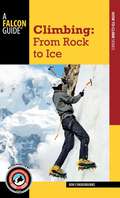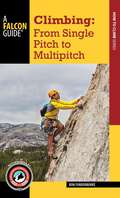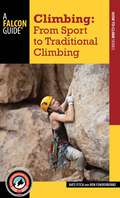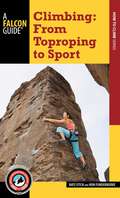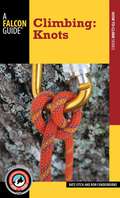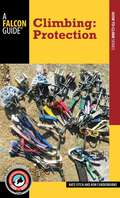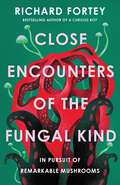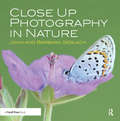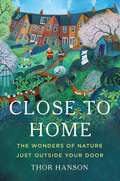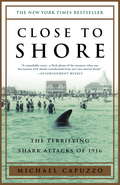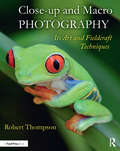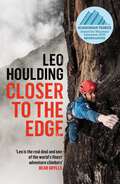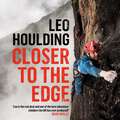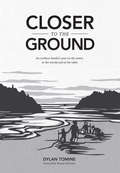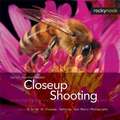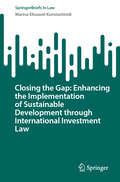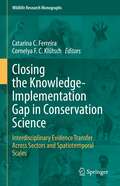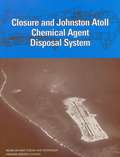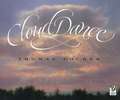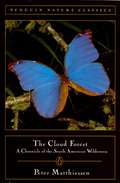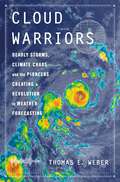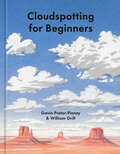- Table View
- List View
Climbing: From Rock to Ice
by Nate Fitch Ron FunderburkeA book about climbing on different terrains, from rock to ice.
Climbing: From Single Pitch to Multipitch
by Ron FunderburkeThis continuation of FalconGuides&’ progressive climbing series invites single pitch climbers to responsibly venture beyond the chains, into the realm of multi-pitch climbing. The farther from the ground a climb leads, the more technical proficiency and careful planning will make the difference between a worthy adventure and miserable epic. Climbing: From Single Pitch to Multi-Pitch complements instruction, ground school, and practice with a procedural approach to planning and preparation, leading anchoring and belaying, transitions, technical descent, and emergency preparedness. Before you get in way way over your head, make sure the essential skills outlined in this book have been reviewed, rehearsed, and individualized.
Climbing: From Sport to Traditional Climbing
by Nate Fitch Ron FunderburkeThis handy, pocket-size manual provides easy-to-understand, step-by-step guidance to climbers transitioning to the advanced level of trad rock climbing.
Climbing: From Toproping to Sport
by Nate Fitch Ron FunderburkeThis handy, pocket-size manual provides easy-to-understand, step-by-step guidance to climbers transitioning from basic rock climbing to sport climbing, which involves scaling larger, more challenging rock walls that have fixed anchors.
Climbing: Knots
by Nate Fitch Ron FunderburkeClimbing: Knots features instructional knot-making information for the novice climber. Pocket-size, it's portable and easy-to-use, with photos throughout to assist with learning.
Climbing: Protection
by Nate Fitch Ron FunderburkeClimbing: Protection is a pocket-size instructional climbing book with the backing of the American Mountain Guides Association (AMGA) that focuses on climbing protection and safety. Complete with color photos throughout, the book features information on environment and terrain, best practices, gear, and more.
Close Encounters of the Fungal Kind: In Pursuit of Remarkable Mushrooms
by Richard ForteyA magical, deeply informed book that takes us from familiar places into the strange world of of fungi.The secret world of fungi is another kingdom. They do things differently there. Diverse beyond our wildest imaginations, fungi don&’t obey rules. They pop up unbidden and often dressed in curious reds and greens. They do not seem of this world, yet fungi underpin all the life around us: the "wood wide web" links the trees by a subterranean telegraph; fungi eat the fallen trunks and leaves to recycle the nutrients that keep the wood alive; they feed a host of beetles and flies, which in turn feed birds and bats. Fungi produce the most expensive foods in the world but also offer the prospect of cheap protein for all; they cure disease, and they both cause disease and kill; they are the specialists to surpass all others; their diversity thrills and bewilders. Professor Richard Fortey has been a devoted field mycologist all his life. He has rejoiced in the exuberant variety and profusion of mushrooms since reading as a boy of nuns driven mad by ergot (a fungus). Drawing on decades of experience, Fortey starts with the perfect "fungus day"—eating ceps in Piedmont. He introduces brown rotters, earthstars, and death caps; fungal annuals and perennials, dung lovers and parasites, even fungi that move through the trees like mycelial monkeys. We learn that the giant puffball produces more spores than there are known stars in the universe and fetid stinkhorns begin looking like arrivals from the planet Tharg. He tells of the fungus that turns flies into zombies, the ones that clean up metallic waste, and the delicious subterranean fungi truffe de Perigord, the delight of gourmets. Amongst these and many other "close encounters," Fortney attempts to answer the questions: what exactly are fungi? Why did their means of reproduction escape discovery for so long? What role do they play in the development of life? The vast kingdom of fungi is more diverse and species rich than plants or animals. By exploring their glorious profusion, Close Encounters of the Fungal Kind reveals so much about their world—and ours.
Close Reading the Anthropocene
by Helena FederReading poetry and prose, images and art, literary and critical theory, science and cultural studies, Close Reading the Anthropocene explores the question of meaning, its importance and immanent potential for loss, in the new geological epoch of the Anthropocene. Both close reading and scientific ecology prioritize slowing down and looking around to apprehend similarities and differences, to recognize and value interconnections. Here "close" suggests careful attention to both the reading subject and read "object." Moving between places, rocks, plants, animals, atmosphere, and eclipses, this interdisciplinary edited collection grounds the complex relations between text and world in the environmental humanities. The volume’s wide-ranging chapters are critical, often polemical, engagements with the question of the Anthropocene and the changing conversation around reading, interpretation, and textuality. They exemplify a range of work from across the globe and will be of great interest to scholars and students of the environmental humanities, ecocriticism, and literary studies.
Close Up Photography in Nature
by John and GerlachCapturing the grandeur of landscapes or mood of a certain natural light is challenging but often the simple details of a texture or color evade photographers most of all. In Close Up Photography in Nature, best-selling authors and nature photography pros, John and Barbara Gerlach, share the tips and techniques necessary to successfully photograph the beauty all around you. The Gerlachs are celebrated teachers who understand a photographer's mind so they begin this book with a brief overview of the fundamentals before delving into some of the more advanced and unique challenges of close up photography. Topics covered include: advanced flash techniques specific for close up shooting, as well as a discussion on focus stacking strategies and tilt-shift lenses for getting maximum depth-of-field. The Gerlachs also discuss their strategy of mixing flash with natural light when shooting close up, which opens up all sorts of photographic possibilities – opening up shadows, creating shadows, separating the subject from the background, reducing contrast between the subject and the background, improving the color rendition, shooting sharper images, and much more. This book will change the way you see the world as well as the way you share it through your work! the world through your work!
Close to Home: The Wonders of Nature Just Outside Your Door
by Thor HansonAn award-winning natural-history writer presents "the perfect mix of science and story" (Sy Montgomery), opening the door to the nature that thrives in our yards, gardens, and parks: "I couldn't put it down" (Doug Tallamy). We all live on nature&’s doorstep, but we often overlook it. From backyards to local parks, the natural places we see the most may well be the ones we know the least. In Close to Home, biologist Thor Hanson shows how retraining our eyes reveals hidden wonders just waiting to be discovered. In Kansas City, migrating monarch butterflies flock to the local zoo. In the Pacific Northwest, fierce yellowjackets placidly sip honeydew, unseen in the treetops. In New England, a lawn gone slightly wild hosts a naturalist's life's work. And in the soil beneath our feet, remedies for everything from breast cancer to the stench of skunks lie waiting for someone&’s searching shovel. Close to Home is a hands-on natural history for any local patch of Earth. It shows that we each can contribute to science and improve the health of our planet. And even more, it proves that the wonders of nature don&’t lie in some far-off land: they await us, close to home.
Close to Shore
by Michael CapuzzoAs the idle rich thronged the palatial hotels of the Jersey Shore in the summer of 1916, America was at its most self-confident. But the world's first industrial superpower was about to receive a series of terrifying shocks. Sharks, it was believed, were not man-eaters, so when a lone Great White shark began to develop a taste for human flesh, America went into total denial. Only after the most horrific attacks was the truth admitted - and an unprecedented national frenzy forced President Woodrow Wilson to mobilize the US Navy in an attempt to put nature back in its place. Combining history and adventure, this is the first book on the events that pitted 20th-century technology against an ancient, mythic enemy and became the model for Peter Benchley's JAWS.
Close to Shore: A True Story of Terror in an Age of Innocence
by Michael CapuzzoThis is a highly readable documentary account of a series of shark attacks on bathers along the New Jersey shore in 1916. The author weaves together the lives of persons who were attacked (four of whom died) and the social milieu of shore culture during the prosperous years before World War I. He also reconstructs the story of the shark, which becomes a character in the narrative.
Close-up and Macro Photography: Its Art and Fieldcraft Techniques
by Robert ThompsonFocusing on fieldcraft techniques for macro and close-up photography, Thompson covers the vital but often overlooked skills necessary to achieve consistent professional results in the field. Case studies covering a broad and often challenging group of subjects from the seashore to your back garden form the core of the lavishly illustrated book. Biology, life history, subject behaviour and ethics along with best practice approaches are discussed in detail and underpinned with photographic tips. The book is divided into four sections—Digital Fundamentals, Fieldcraft & Methodology, Portfolio Case Studies, Digital Workflow & Presentation—covering the full photographic process from capture through to editing, captioning, development and storage are discussed. Moving beyond the surface-level approach to macro instruction, this book provides readers with techniques that work in the field. Illustrated with over 250 of the author's own inspiring images, this publication is a must for photographers, naturalists and anyone interested in improving their macro skills in the field.
Closer to the Edge: Climbing to the Ends of the Earth
by Leo HouldingOne of Great Britain's finest climbers and adventurers, Leo Houlding started out climbing at ten years of age in the Lake District literally learning the ropes tackling the many historic peaks and crags in the area. Honing his skills as he grew, at eighteen Leo became one of the very first to free climb the mighty El Capitan in the Yosemite Valley, California widely regarded as the most impressive rock face on the planet cementing his reputation as a world class climber. He has since gone on to not only summit the world's tallest walls and toughest peaks, but has become a twenty-first Century explorer, crossing continents to take extreme sports to the most remote corners of Earth - from the frozen mountains of Antarctica to the sweltering jungles of South America How did a working class lad from the north of England scale such heights and avoid the pitfalls and fatal accidents that have struck down so many of his colleagues and friends? Honest, raw and exhilarating, Closer to the Edge is Leo's 'warts-and-all' insight into the extreme life of one of Britain's best climbers who is active today and still planning epic adventures. In a page-turning narrative, Leo describes his childhood inspirations to climb, his mentors who guided him, and the exhilaration of those teenage years when he broke into the public consciousness - such as his infamous race against Jeremy Clarkson on Top Gear. He will reveal to the reader what drives him, how he assesses risk and judges how close to the edge he can go and return safely, and how he balances this with teaching his own children the lessons he has learnt in some of the world's most dangerous and extreme places. Closer to the Edge is the story of a remarkable climber and free spirit who has been at the top of his game for over thirty years, with still more mountains to explore.
Closer to the Edge: Climbing to the Ends of the Earth
by Leo HouldingLeo Houlding started climbing at ten years of age in the Lake District and was the youngest person (and first Briton) to free climb El Capitan in Yosemite National Park in the United States at eighteen years, which cemented his reputation. He has since gone on to summit the world's toughest peaks and explore the most extreme places on our planet. During such explorations he has had to deal with tragedy when close friends and colleagues have been killed or badly injured, and he will discuss how you deal with such loss and carry on. Honest, raw and exhilarating, Closer to the Edge will be a 'warts-and-all' insight into the extreme life of one of Britain's best mountaineer adventurers. What drives him? How does he assess risk and judge what level he'll take himself to be successful, and how does he balance this with teaching his own children the lessons he has learnt in some of the world's most dangerous and extreme places.(P) 2022 Headline Publishing Group Ltd
Closer to the Ground
by Thomas Mcguane Nikki Mcclure Dylan TomineCloser to the Ground is the deeply personal story of a father learning to share his love of nature with his children, not through the indoor lens of words or pictures, but directly, palpably, by exploring the natural world as they forage, cook and eat from the woods and sea. With illustrations by Nikki McClure.This compelling, masterfully written tale follows Dylan Tomine and his family through four seasons as they hunt chanterelles, fish for salmon, dig clams and gather at the kitchen table, mouths watering, to enjoy the fruits of their labor. Closer to the Ground captures the beauty and surprise of the natural world-and the ways it teaches us how to live-with humor, gratitude and a nose for adventure as keen as a child's. It is a book filled with weather, natural history and many delicious meals.
Closeup Shooting
by Cyrill HarnischmacherClose-up photography is one of the most fascinating areas in photography. This illustrated guide will take the reader on a journey into the wonderful world of small, smaller, and smallest objects and show him how he can capture their beauty with photographic images. Each step of the way will be carefully explained; how to choose the right equipment, how to use ambient light or create artificial lighting, and how to conceptualize and frame the perfect shot. Whereas the nature photographer is exploring facets and structures in his environment, the "table top photographer" is trying to shoot a small object, a product, or a small treasure for display on the web (e.g., eBay) or in print. Here, the choice of the appropriate lighting and backdrop, and the creative use of the camera's features are key to a perfect image. Cyrill Harnischmacher explains all aspects of close-up shooting for both inside the studio, as well as outdoors. This book is filled with beautifully illustrated examples and detailed instructions on how to set up a system and workflow for successful close-up photography.
Closing the Gap: Enhancing the Implementation of Sustainable Development through International Investment Law (SpringerBriefs in Law)
by Marina-Elissavet KonstantinidiThis book examines the applicability of the United Nations' Sustainable Development Goals within the framework of International Investment Law, assessing its effectiveness and identifying areas in need for reform. It aims to contribute to a strategic approach for sustainable development in the era of globalization, addressing pressing social concerns. More specifically, this book explores if and how the tools offered by international investment law can be utilized to advance the principles of sustainable development. The study further investigates how the notion of sustainable development affects the arguments regarding the existence of a protected investment, and potential violations of investment treaty clauses concerning, namely, the fair and equitable treatment standard, illegal expropriation and umbrella clauses. It aims to provide suggestions for reform, focusing on the creation of preventive mechanisms, in addition to existing repressive ones. The above-mentioned issues have direct influence on key areas of public interest, such as environmental protection and public health, which ar integral to sustainable development. It is crucial to ensure that investment protection does not come at the expense of the above, and international investment law can rather be used as a tool for positive change at a global scale. It is, therefore, of utmost importance to identify existing conflicts in the field and raise concerns, in order to achieve a balance of interests between States and investors, and take a step closer to the realization of the UN Sustainable Development Goals.
Closing the Knowledge-Implementation Gap in Conservation Science: Interdisciplinary Evidence Transfer Across Sectors and Spatiotemporal Scales (Wildlife Research Monographs #4)
by Catarina C. Ferreira Cornelya F. C. KlütschThis book aims to synthesize the state of the art on biodiversity knowledge exchange practices to understand where and how improvements can be made to close the knowledge-implementation gap in conservation science and advance this interdisciplinary topic. Bringing together the most prominent scholars and practitioners in the field, the book looks into the various sources used to produce biodiversity knowledge - from natural and social sciences to Traditional Ecological Knowledge and Citizen Science - as well as knowledge mobilization approaches to highlight the key ingredients that render successful conservation action at a global scale. By doing so, the book identified major current challenges and opportunities in the field, for different sectors that generate, mobilize, and use biodiversity knowledge (like academia, boundary organizations, practitioners, and policy-makers), to further develop cross-sectorial knowledge mobilization strategies and enhance evidence-informed decision-making processes globally.
Closure And Johnston Atoll Chemical Agent Disposal System
by Committee on Review Evaluation of the Army Chemical Stockpile Disposal ProgramJohnston Atoll Chemical Agent Disposal System (JACADS), the first fully integrated chemical agent disposal facility, is located on Johnston Island some 800 miles southwest of Hawaii. JACADS completed ten years of operations in November 2000, which resulted in the disposal of more than 2000 tons of nerve and mustard agents. In 1998, the Army began planning for closure and dismantling of the facility. In 1999, the NRC was asked to review the Army's planning. This book presents an assessment of planned and ongoing closure activities on Johnston Island in some detail. It also provides an analysis of the likely implications for closure of disposal facilities at eight continental U. S. storage sites.
Cloud Dance
by Thomas LockerJourney across the heavens through thick cumulus clouds, wispy cirrus clouds, and wide stratus clouds as they dance through every season of the year. Thomas Locker introduces young readers to the basic science of our natural world with brilliant illustrations and poetic prose.
Cloud Forest: A Chronicle of the South American Wilderness
by Peter MatthiessenPeter Matthiessen crisscrossed 10,000 miles of the South American wilderness, from the Amazon rain forests to Machu Picchu, high in the Andes, down to Tierra del Fuego and back. He followed the trails of old explorers, encountered river bandits, wild tribesmen, and the evidence of ancient ruins, and discovered fossils in the depths of the Peruvian jungle. The Cloud Forest is his incisive, wry report of his expedition into this vast world to the south.
Cloud Warriors: Deadly Storms, Climate Chaos—and the Pioneers Creating a Revolution in Weather Forecasting
by Thomas E. WeberThe unprecedented inside story of the people pushing boundaries of science and technology to build better weather forecasts—providing life-saving warnings and crucial intelligence about nature’s deadliest threatsKiller tornadoes. Catastrophic hurricanes. Lethal heat waves. Across the United States and around the world, extreme weather events bring an unending torrent of death and destruction. One indispensable tool consistently offers the ability to help reduce the impact of these calamities: the weather forecast. For centuries, humans have sought to foretell nature’s next moves, from ancient farmers to trailblazers of the Space Age, who brought computers and satellites to bear on the problem. Now a new wave of advances, including artificial intelligence and data-gathering drones, makes it possible to accurately detect these fearsome events further in advance. They provide critical time to prepare and get people out of harm’s way—an undertaking made ever more urgent by the effects of climate change.In a remarkable tale of innovation and perseverance, veteran journalist Thomas E. Weber takes readers into the world of the pioneers creating these game-changing forecasts. From storm chasers racing to hunt twisters and physicists unraveling the secrets of the atmosphere, from scientists studying how people react to warnings to humanitarian groups rushing to avert famines, Weber goes behind the scenes to show how predictions keep getting better. He explains what’s needed to turn these forecasts into actions that prevent tragedies and how anyone can become more weather literate to protect themselves in emergencies. Cloud Warriors will change the way you think about treacherous weather—and the power of being able to see it coming.
Clouds (Let's Read and Find Out Science)
by Anne Rockwell Frané LessacDo you ever wake up and wonder what the weather will be? Instead of turning on the TV to find out, you can just look out your window at the clouds. How do you know what type of clouds can forecast a change of weather? Read and find out.
Cloudspotting for Beginners
by Gavin Pretor-Pinney William GrillA beautifully illustrated guide to clouds and the sky for inspiring and educating curious minds with meteorological wonder.Renowned journalist, public speaker, and founder of the Cloud Appreciation Society Gavin Pretor-Pinney details the key facts and characteristics about each major cloud type. To accompany these scientific tidbits, William Grill&’s gorgeous illustrations of vast colorful skies and mesmerizing cloud patterns create a calming, thought-provoking learning experience.From low-lying Stratus to high-flying Cirrus, Cloudspotting for Beginners covers how clouds are formed, the altitudes they prefer, the curious shapes they take, how they affect other meterological events, and more. The book breaks down the life and structure of a cloud on a molecular level, and then even expands on their interesting cross-planetary variations—for example, Jupiter&’s clouds are composed of ammonia ice crystals and Saturn&’s clouds congregate in an inexplicable hexagon around the planet's North Pole.Clouds require a fascinating amount of chemical precision in order to exist, yet they disappear and form again on a daily basis with ease. Cloudspotting for Beginners is a whimsical lesson on the oft-overlooked extraordinary lives of clouds that will serve as a gentle reminder to be present and observant in the face of impermanence. Just as informative as it is poetic and peaceful, this is the perfect guide for cloud appreciators and sky lovers.
